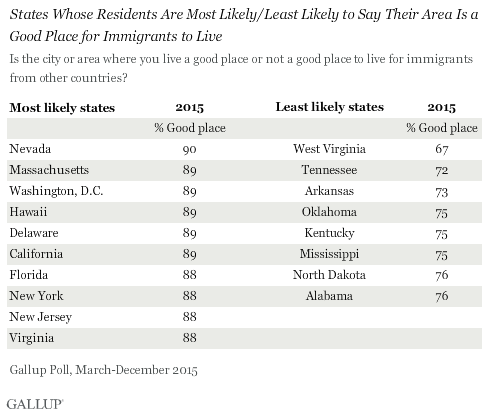Story Highlights
- W. Virginians least likely to say their area good for immigrants
- East Coast residents view their states as being most hospitable
- Southern, Midwestern states least likely to say area a "good place"
WASHINGTON, D.C. -- Ninety percent of Nevada residents indicate their area is hospitable to immigrants, the highest among the 50 U.S. states and the District of Columbia. Nevada is followed closely by four states -- Massachusetts, Hawaii, Delaware and California, plus Washington, D.C. -- all at 89%.

West Virginia has the lowest proportion of residents, 67%, who say their state is a good place for immigrants to live, though this is still a solid majority.
Residents of several East Coast states are among the most likely to say the city or area where they live is a good place for immigrants from other countries. In addition to Massachusetts and Delaware, in Florida, New York, New Jersey and Virginia, along with the District, at least 88% of residents express this sentiment. This is also true for residents of Nevada, Hawaii and California.
Meanwhile, residents of several Southern states are among the least likely to say their city or area is hospitable to immigrants. Between 72% and 77% of adults in Tennessee, Arkansas, Mississippi, Kentucky, Oklahoma and Alabama say this. North Dakotans are also among the least likely to say this about their area. The complete list of states can be found at the end of this article.
An average of 82% nationwide say their local area is a good place for immigrants to live in Gallup's 2015 comprehensive poll of 50 states and Washington, D.C. The poll consisted of 500 interviews or more in each state and the District. Interviewing was conducted from March-December 2015, at a time when immigration was a major issue in the presidential campaign. The immigration debate focused largely on building a wall on the U.S.-Mexico border, how to address the status of immigrants currently in the country illegally and whether the U.S. should take in Syrian refugees who fled the civil war there.

In Arizona, where residents still live under the controversial SB 1070 -- a state law considered one of the strictest anti-illegal-immigration measures in the country when it passed in 2010 -- 81% say their area is a good place for immigrants to live. Although a strong majority, the figure is slightly below average, and falls at least five percentage points below the scores of neighboring states -- California, Nevada, Utah, Colorado and New Mexico.
While Alabama residents, who also live under a controversial anti-illegal immigration law, are among the least likely to indicate that their city or area is hospitable to immigrants (76%), residents just across the border in Florida (88%) are much more likely to say this.
Bottom Line
In each of the 50 states and the District of Columbia, a solid majority of residents feel their city or area is a good place for immigrants to live. But responses to this question vary somewhat by state.
The status and future of immigrants who are in the U.S. illegally -- about half of whom are Mexicans -- have produced a bevy of hot-button political issues this election year. While about for such immigrants, many have flocked to support GOP presidential front-runner Donald Trump. Trump has insisted that Mexico is "not sending [its] best" to the U.S., suggesting that immigrants from that country are bringing problems such as drugs and rape, and that a wall must be built on the countries' common border and paid for by Mexico.
Although many have rejected Trump's comments and positions, he recently received the endorsements of former Arizona Gov. Jan Brewer, who signed the state's anti-illegal immigration bill, and another anti-illegal-immigration icon, Alabama Sen. Jeff Sessions.
Americans' views of their area as a good place for immigrants to live might not necessarily be related to their views on how to address illegal immigration, but the latter could be a factor in how the states vary. Regardless of residents' views on illegal immigration, they may not be inclined to say anything that would make it appear that their local area is unwelcoming to outsiders, which could play a role in why the percentages are fairly high in all of the states. It seems that, despite variations across the country, a strong majority of Americans everywhere believe their towns would welcome "huddled masses yearning to breathe free."
These data are available in .
Survey Methods
Results for this 优蜜传媒poll are based on telephone interviews conducted March 30-Dec. 22, 2015, with random samples of approximately 500 adults, aged 18 and older, living in each of the 50 U.S. states. Data are weighted to account for unequal selection probability, nonresponse and double coverage of landline and cellphone users in the two sampling frames. Data are also weighted to state estimates of gender, age, race, Hispanic ethnicity, education and phone status (cellphone only, landline only, both, and cellphone mostly).
For results based on the total sample of adults in each state, the margin of sampling error is ±6 percentage points at the 95% confidence level. All reported margins of sampling error include computed design effects for weighting.
Each state sample includes roughly 60% cellphone respondents and 40% landline respondents. Landline and cellular telephone numbers are selected using random-digit-dial methods.


